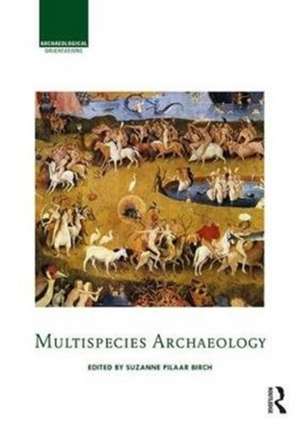Multispecies Archaeology: Archaeological Orientations
Editat de Suzanne Pilaar Birchen Limba Engleză Hardback – 20 feb 2018
Encompassing more than just our relationships with animals, the book considers what we can learn about the human past without humans as the focus of the question. The volume digs deep into our understanding of interaction with plants, fungi, microbes, and even the fundamental building blocks of life, DNA. Multispecies Archaeology examines what it means to be human—and non-human—from a variety of perspectives, providing a new lens through which to view the past.
Challenging not only the subject or object of archaeology but also broader disciplinary identities, the volume is a landmark in this new and evolving area of scholarly interest.
| Toate formatele și edițiile | Preț | Express |
|---|---|---|
| Paperback (1) | 303.81 lei 6-8 săpt. | |
| Taylor & Francis – 30 iun 2020 | 303.81 lei 6-8 săpt. | |
| Hardback (1) | 1218.12 lei 6-8 săpt. | |
| Taylor & Francis – 20 feb 2018 | 1218.12 lei 6-8 săpt. |
Preț: 1218.12 lei
Preț vechi: 1965.06 lei
-38% Nou
Puncte Express: 1827
Preț estimativ în valută:
233.12€ • 242.48$ • 192.45£
233.12€ • 242.48$ • 192.45£
Carte tipărită la comandă
Livrare economică 15-29 aprilie
Preluare comenzi: 021 569.72.76
Specificații
ISBN-13: 9781138898981
ISBN-10: 1138898988
Pagini: 390
Ilustrații: 74
Dimensiuni: 174 x 246 x 24 mm
Greutate: 0.93 kg
Ediția:1
Editura: Taylor & Francis
Colecția Routledge
Seria Archaeological Orientations
Locul publicării:Oxford, United Kingdom
ISBN-10: 1138898988
Pagini: 390
Ilustrații: 74
Dimensiuni: 174 x 246 x 24 mm
Greutate: 0.93 kg
Ediția:1
Editura: Taylor & Francis
Colecția Routledge
Seria Archaeological Orientations
Locul publicării:Oxford, United Kingdom
Cuprins
Part I: Living in the Anthropocene; 1. Calabrian Hounds and Roasted Ivory; 2. The End of the ‘Neolithic’? At the emergence of the Anthropocene; 3. Rehearsing the Anthropocene in microcosm: the palaeoenvironmental impacts of the Pacific rat (Rattus exulans) and other non-human species during island Neolithization; 4. Trans-Holocene Human Impacts on California Mussels (Mytilus californianus): Historical Ecological Management Implications from the Northern Channel Islands; 5. Drift; 6. Symbiotic Architectures; 7. The Eco-Ecumene and Multispecies History: The Case of Abandoned Protestant Cemeteries in Poland; 8. Ecologies of Rock and Art in Northern New Mexico; 9. Oysters and Mound-Islands of Crystal River along the Central Gulf Coast of Florida; 10. Multi-species Dynamics and the Ecology of Urban Spaces in Roman Antiquity; 11. Mammalian Community Assembly in Ancient Villages and Towns in the Jordan Valley of Israel; 12. Animals and the Neolithic: cui bono?; 13. Making space from the position of duty of care: Early Bronze Age human - sheep entanglements in Norway.; 14. The History of the Human Microbiome: Insights from Archaeology and Ancient DNA; 15. An archaeological telling of multispecies co-inhabitation: comments on the origins of agriculture and domestication narrative in southwest Asia; 16. Legs, feet and hooves: the seasonal roundup in Iceland; 17. The Rhythm of Life: Exploring the role of daily and seasonal rhythms in the development of human-nonhuman relationships in the British Early Mesolithic; 18. Seasonal mobility and multispecies interactions in the Mesolithic northeastern Adriatic; 19. The role of ostrich in shaping the landscape use patterns of humans and hyenas on the southern coast of South Africa during the late Pleistocene; 20. Prey species movements and migrations in ecocultural landscapes: reconstructing late Pleistocene herbivore seasonal spatial behaviors; Index
Notă biografică
Suzanne E. Pilaar Birch is Assistant Professor at the University of Georgia with a joint appointment in the departments of Anthropology and Geography. She combines zooarchaeology and biogeochemistry to investigate changes in diet, environment, mobility, and settlement systems spanning the late Pleistocene and early Holocene.
Descriere
Multispecies Archaeology explores the issue of ecological and cultural novelty in the archaeological record from a multispecies perspective. Encompassing more than just our relationships with animals the book considers what we can learn about the human past without humans as the focus of the question. The volume digs deep into our understanding of interaction with plants, fungi, microbes, and even the fundamental building blocks of life, DNA. Multispecies Archaeology examines what it means to be human—and non-human—from a variety of perspectives providing a new lens through which to view the past.






